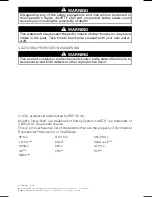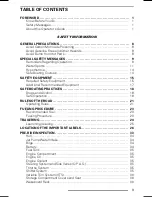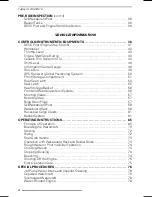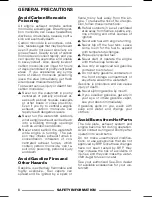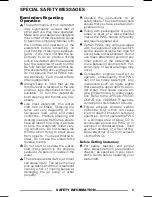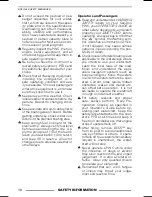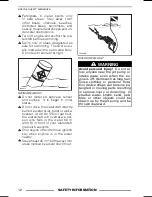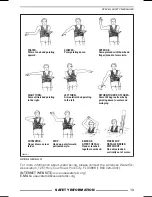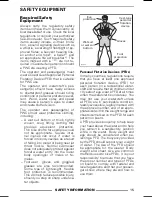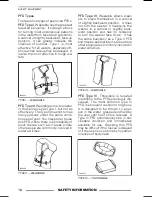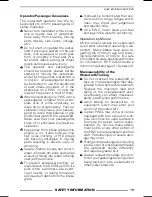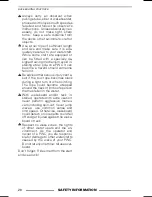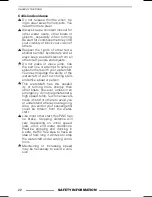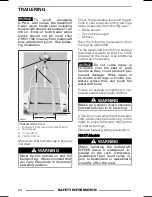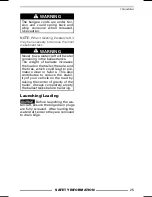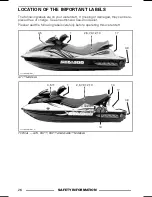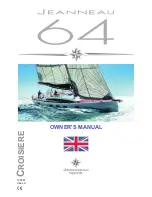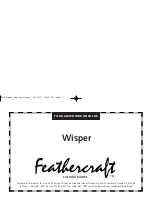
SPECIAL SAFETY MESSAGES
At least one passenger should be
able to operate the watercraft in
case the operator is unexpectedly
unable to do so.
Operation of this PWC by a person
under 16 years of age or a person
with a disability that impairs vision,
reaction time, judgment, or opera-
tion of the controls is NOT recom-
mended.
Always use the safety lanyard when
operating the watercraft and ensure
that all passengers are familiar with
its use.
Ensure that any operator and all pas-
sengers know how to swim and
how to re-board the PWC from
the water. Boarding in deep wa-
ter can be strenuous. Practice in
chest-deep water before operat-
ing or embarking your watercraft
in deep water. If a passenger does
not know how to swim, ensure that
passenger wears a PFD at all times
and take extra precautions when
boating.
Water Sports
WARNING
Avoid personal injury!
Your PWC
is not designed for and should not
be used for pulling parasails, kites,
gliders, or any device which can
become airborne. Use watercraft
only for appropriate water sports.
Water skiing, wakeboarding, or riding
a towed, inflatable apparatus are some
of the more popular water sports. Tak-
ing part in any water sport requires
increased safety awareness by the par-
ticipant and the watercraft operator. If
you have never pulled someone be-
hind your PWC before, it is a good idea
to spend some hours as an observer,
working with and learning from an ex-
perienced driver. It is also important to
be aware of the skill and experience of
the person being pulled. Always have
a second person on board to observe
the person in the water so the driver
can concentrate on operating the wa-
tercraft.
Both the operator and observer should
monitor the location of the towrope
when participating in watersports. A
slack tow rope can become entangled
with person(s) or objects on the PWC
or in the water, particularly when mak-
ing a tight turn or circling, and cause
serious personal injury.
Everyone participating in a water sport
should observe these guidelines:
Allow only capable swimmers to
take part in any water sport.
Always wear an approved personal
flotation device (PFD). Wearing
a properly designed PFD helps a
stunned or unconscious person stay
afloat. A Type-IV water-ski vest is an
approved and practical PFD.
Have a second person aboard to
observe the person being towed
and inform the driver about the par-
ticipant's hand signals. The driver
must give full attention to operat-
ing the watercraft and the waters
ahead.
Be considerate to others you share
the water with.
Do not tow a person in any water
sport on a short tow rope such that
the person inhales exhaust fumes
in concentration. Inhalation of con-
centrated exhaust fumes, which
contain carbon monoxide, can re-
sult in CO poisoning, personal injury
and death.
Give immediate attention to a per-
son who has fallen. He or she is
vulnerable in the water alone and
may not be seen by other boaters.
Approach a person in the water from
the lee side (opposite the direction
of the wind). Turn off the motor be-
fore coming close to the person.
________
SAFETY INFORMATION
________
11
Содержание 2009 Sea-Doo GTI Series
Страница 9: ...SAFETY INFORMATION ________ SAFETY INFORMATION ________ 7...
Страница 30: ...LOCATION OF THE IMPORTANT LABELS F16L0PL LABEL 1 TYPICAL RXP MODELS 28 _______ SAFETY INFORMATION ________...
Страница 39: ...VEHICLE INFORMATION _______________ 37...
Страница 83: ...MAINTENANCE INFORMATION _______________ 81...
Страница 100: ...STORAGE AND PRESEASON PREPARATION 98 ______________...
Страница 101: ...TECHNICAL INFORMATION _______________ 99...
Страница 114: ...SPECIFICATIONS 112 ______________...
Страница 115: ...TROUBLESHOOTING ______________ 113...
Страница 123: ...WARRANTY ______________ 121...
Страница 142: ...140 ______________...
Страница 144: ...142 ______________...
Страница 146: ...144 ______________...


